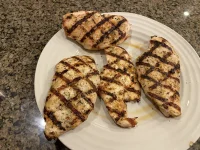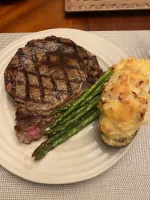Navigation
Install the app
How to install the app on iOS
Follow along with the video below to see how to install our site as a web app on your home screen.
Note: This feature may not be available in some browsers.
More options
Style variation
You are using an out of date browser. It may not display this or other websites correctly.
You should upgrade or use an alternative browser.
You should upgrade or use an alternative browser.
GrillGrate advice needed
- Thread starter Brad S
- Start date
Tyler6590
Member
I was going to ask the same thing. Just bought some and will be doing a reverse sear tritip and some chicken this Saturday. I'll update how it goes but I would love to hear other's experiences/advice.
JpsBBQ
Well-known member
- Joined
- May 17, 2020
- Messages
- 1,882
- Reaction score
- 2,680
- Location
- United States
- Grill
- Smokefire ex 4, WSM 22, Weber Summit charcoal S6, Weber 22” kettle, Weber Summit natural gas grilling station, various Traegers, Camp Chef WW36, couple BGE’s, pit barrel cooker, and some other stuff
I seasoned mine with some spray oil. They just brown up a bit. They will get @ 150 degrees higher than the regular grates. I just brush them down with the Weber triangle brush. I use the slotted spatula to clear out the troughs when they get crap in them. Enjoy!
I don’t use them on my SmokeFire but do on my Genesis. Like JpsBBQ mentioned, the definitely get hotter at same settings as regular grates so be prepared to account for that. On my Genesis med with the GrillGrates equals hi without. I rub half an onion on them every once in a while too seems to help with sticking depending on what I’m cooking.
I also keep two sections upside down to use for full sears, vegetables, or toasting buns.
I also keep two sections upside down to use for full sears, vegetables, or toasting buns.
JpsBBQ
Well-known member
- Joined
- May 17, 2020
- Messages
- 1,882
- Reaction score
- 2,680
- Location
- United States
- Grill
- Smokefire ex 4, WSM 22, Weber Summit charcoal S6, Weber 22” kettle, Weber Summit natural gas grilling station, various Traegers, Camp Chef WW36, couple BGE’s, pit barrel cooker, and some other stuff
I don’t believe ive used them in my Smokefire either. But ive used them on other grills quite a bit over the last few years. They are as advertisedI don’t use them on my SmokeFire but do on my Genesis. Like JpsBBQ mentioned, the definitely get hotter at same settings as regular grates so be prepared to account for that. On my Genesis med with the GrillGrates equals hi without. I rub half an onion on them every once in a while too seems to help with sticking depending on what I’m cooking.
I also keep two sections upside down to use for full sears, vegetables, or toasting buns.
- Thread Starter
- #6
I'm hoping to get a better sear on my smokefire. For say...1" steaks or 1/3 pounder hamburgers, was wondering if I should reverse sear - low part on regular grate and sear on the grillgrates, or if I should keep them on the grillgrates from the start? My first attempt was on my gasser - I rubbed some onion on the grates during the heat up but the meats stuck like super glue. Does the onion help right away or will it take time to build up?I don’t use them on my SmokeFire but do on my Genesis. Like JpsBBQ mentioned, the definitely get hotter at same settings as regular grates so be prepared to account for that. On my Genesis med with the GrillGrates equals hi without. I rub half an onion on them every once in a while too seems to help with sticking depending on what I’m cooking.
I also keep two sections upside down to use for full sears, vegetables, or toasting buns.
JpsBBQ
Well-known member
- Joined
- May 17, 2020
- Messages
- 1,882
- Reaction score
- 2,680
- Location
- United States
- Grill
- Smokefire ex 4, WSM 22, Weber Summit charcoal S6, Weber 22” kettle, Weber Summit natural gas grilling station, various Traegers, Camp Chef WW36, couple BGE’s, pit barrel cooker, and some other stuff
My advice would be to buy thicker steaks. Any chef worth his salt would tell you to never buy a steak less than 1.5” thick. This allows for proper sear without totally overcooking the protein. Reverse sear is only useful for large cuts and roasts. I would reserve that method for steaks 2” and thicker. A 1” steak will cook very fast and require screaming hot fire to get a decent sear. The grill grates will definitely help as they do as advertised. They do increase the surface temp over SS or cast iron. Good luck.I'm hoping to get a better sear on my smokefire. For say...1" steaks or 1/3 pounder hamburgers, was wondering if I should reverse sear - low part on regular grate and sear on the grillgrates, or if I should keep them on the grillgrates from the start? My first attempt was on my gasser - I rubbed some onion on the grates during the heat up but the meats stuck like super glue. Does the onion help right away or will it take time to build up?
- Thread Starter
- #8
I would like thicker but I buy 1/4 cows and they don't give me the option. You have to buy a 1/2 or whole cow to get a custom cut list. I'll just have to suffer with 1" steaksMy advice would be to buy thicker steaks. Any chef worth his salt would tell you to never buy a steak less than 1.5” thick. This allows for proper sear without totally overcooking the protein. Reverse sear is only useful for large cuts and roasts. I would reserve that method for steaks 2” and thicker. A 1” steak will cook very fast and require screaming hot fire to get a decent sear. The grill grates will definitely help as they do as advertised. They do increase the surface temp over SS or cast iron. Good luck.
JpsBBQ
Well-known member
- Joined
- May 17, 2020
- Messages
- 1,882
- Reaction score
- 2,680
- Location
- United States
- Grill
- Smokefire ex 4, WSM 22, Weber Summit charcoal S6, Weber 22” kettle, Weber Summit natural gas grilling station, various Traegers, Camp Chef WW36, couple BGE’s, pit barrel cooker, and some other stuff
Well, the thinner the steak, the faster it cooks. So, if you want anything med rare you have to get the grates screaming hot and sear quickly as to not overcook the middle of the steak. Like I said before reverse sear or even forward sear followed by the traditional roasting time after the sear is reserved for cuts of @2” thick and above or for roasts that have the mass that warrants such a process. So, it’s either treat yourself to some thicker steaks for those more special occasions, or you hav e to settle for the limitations of what you already have. Either way, do your best and enjoy.I would like thicker but I buy 1/4 cows and they don't give me the option. You have to buy a 1/2 or whole cow to get a custom cut list. I'll just have to suffer with 1" steaks
- Thread Starter
- #11
Good advice. Wonder if you can tie 2 thin steaks together and cook like its 1 thick one?Well, the thinner the steak, the faster it cooks. So, if you want anything med rare you have to get the grates screaming hot and sear quickly as to not overcook the middle of the steak. Like I said before reverse sear or even forward sear followed by the traditional roasting time after the sear is reserved for cuts of @2” thick and above or for roasts that have the mass that warrants such a process. So, it’s either treat yourself to some thicker steaks for those more special occasions, or you hav e to settle for the limitations of what you already have. Either way, do your best and enjoy.
Wilkie
New member
- Joined
- Dec 5, 2020
- Messages
- 14
- Reaction score
- 23
- Location
- North Carolina
- Grill
- Summit Charcoal, 26” Kettle, Genesis Gas & EX 4 SmokeFire
I use them a fair amount of the time. They do a great job of putting nice sear marks on the meat. I generally go 500 - 525 degrees. I put the grates on during the heat up phase and when the grill comes up to temp I put the meat on. 1/4 turn half way through on one side then flip & repeat. I generally don't worry about the appearance on the 2nd side as much because you only see one side of the protein when you serve it. One tip I recommend is after you finish cooking on the grill grates flip them upside down when you are done and during the shutdown phase and it will cook off a lot of the debris left over by the meat. This cleaning method works better on a charcoal grill because it stays hotter longer during its cool down but it does a reasonably good with smoke fire. Hope this helps.
Attachments
JpsBBQ
Well-known member
- Joined
- May 17, 2020
- Messages
- 1,882
- Reaction score
- 2,680
- Location
- United States
- Grill
- Smokefire ex 4, WSM 22, Weber Summit charcoal S6, Weber 22” kettle, Weber Summit natural gas grilling station, various Traegers, Camp Chef WW36, couple BGE’s, pit barrel cooker, and some other stuff
Again, sous vide (like reverse sear) is only useful on larger/thicker cuts IMO. I would get the steaks as cold and raw as possible to avoid the center rising above my desired temp before I had achieved a decent sear. Anything you do to increase the internal temp or cook it prior to the sear, of a thin cut, is counter to your desired result. Unless that desired result is a well done cook temperature. In which case, you have already ruined it.With thin steaks, you might try a solid vide cook, chill down, and then sear the outside. It would work but missing the grilled flavor.










